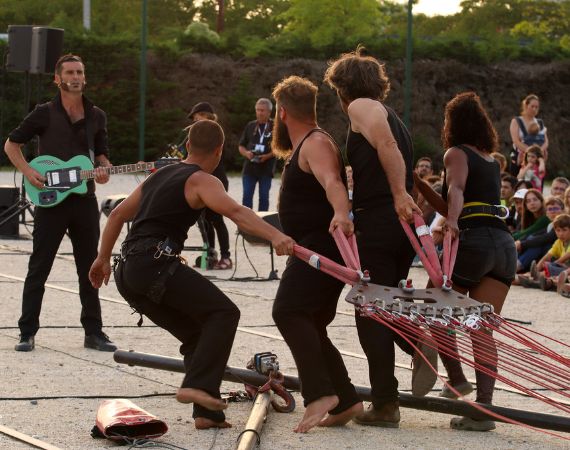
Research and Evolution of Circus Practices
Basinga sees the discipline of tightrope walking as a collective art. This is far from the image of the artist alone on his tightrope, on whom the whole show depends. Basinga’s work is the fruit of collaboration and interdependence between the musicians, the tightrope walker and the technical staff. Each needs the other, each feeds the other, each complements the other to create shows with a very singular universe.
This desire for cross-disciplinary collaboration extends beyond the shows themselves, with the aim of moving the limits of circus practice. Tatiana-Mosio Bongonga collaborates with a wide range of people not only to develop her own discipline, but also to develop circus arts practices as a whole. For example, Tatiana-Mosio Bongonga integrates physical and mental preparation as for top-level athletes, post-partum physical recovery to avoid irreversible accidents, careful attention to nutrition or an introduction to writing choreographic sequences on score using the Benesh method adapted to the circus by Katrin Wolf.
Basinga works to develop the art of tightrope walking and, more broadly, the spirit of the circus, through technical research and transdisciplinary collaboration. This desire for collaboration and collective achievement is deeply rooted in the company’s DNA.
Research & Technical and Safety Development
To create paths in the sky, you need to know how to create invisible paths. While a high-wire tightrope seems simply to be supported by the wind, defying gravity, it prosaically obeys the laws of physics and mechanics.
This taut wire will have to support tons of pressure, anchoring itself to old buildings, modern facades, rocks or trees without damaging them. It will sometimes have to withstand slopes of up to 20% without tearing away from its anchor points. It must also be stable to avoid undulation or resonance with the wind or with the artist’s footsteps. And last but not least, it must be able to support the weight of several people, so that if a tightrope walker gets stuck, he or she can be safely rescued.
Basinga contributes to the technical and safety evolution of a new discipline, the highline. We collaborate with a think-tank on these trades to share knowledge and equipment. We are also working with major industrial groups to design new materials and equipment dedicated to the practice of high-altitude disciplines.


Jan Naets, co-founder of the company and Technical Director, and his team are constantly developing and designing new hanging systems by repurposing tools and equipment originally created for the nautical and climbing sectors. They are clearing out and documenting a niche profession, that of the highliner, while creating specialized equipment.
The highline is between the professions of rope access technicians, riggers and rope rescue, forcing these technical teams to invent their own standards to secure and design such amazing feats of assembly. To this end, Jan contributes to the Rope ‘n Web think-tank and training group, which brings together experts in these disciplines to share knowledge and specific equipment.
Basinga also works on the research and development of new equipment in collaboration with specialist companies such as Harken (nautical) and Petzl (climbing). It is by developing this type of partnership that the company has innovated in tightrope-walking equipment. For example, with the company Cousin Trestec, and the support of the Centre National des Arts du Cirque (National Centre for Circus Arts), we designed a nylon thread braided in a certain way, thus keeping the flexibility necessary for tightrope walking over long distances.
If you’re a company specializing in rope access, nautical or climbing equipment, and you’d like to test your equipment in conditions different from those in which you’re used to working, please contact us.
Katrin Wolf, who has dual skills as a circus artist and choreologist, is working on a project to create a specific transcription tool for the circus arts using Benesh notation. Her main objective is to develop a method of movement notation adapted to circus disciplines.
Tatiana-Mosio Bongonga, who has been introduced to Benesh notation, intends to develop this form of writing for tightrope walkers, in order not only to archive but also to pass on or re-appropriate the sequences of a performance.

Read more on Benesh rating

